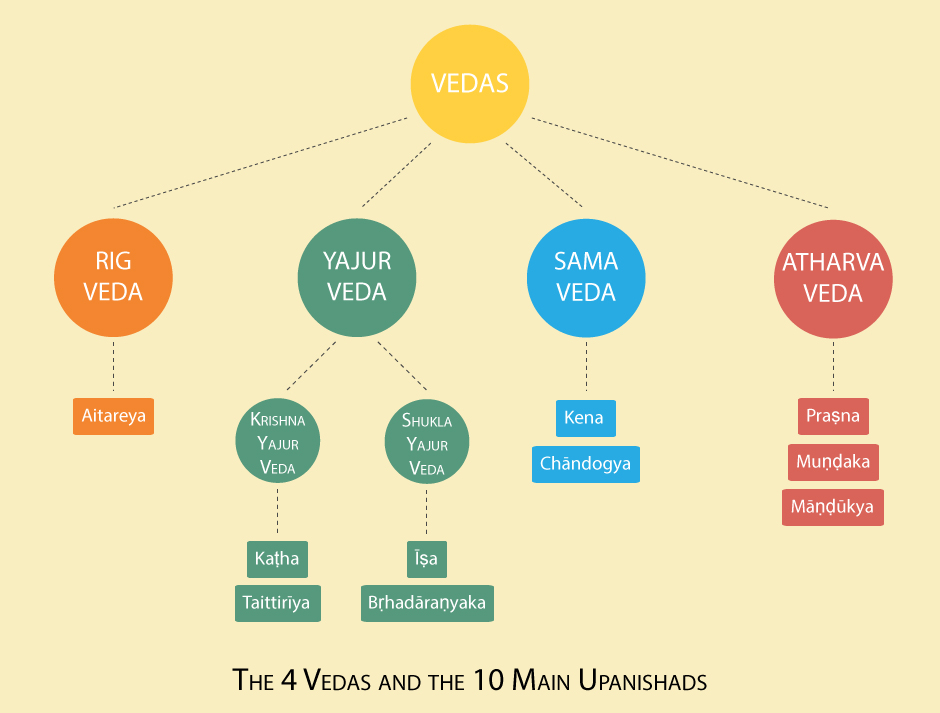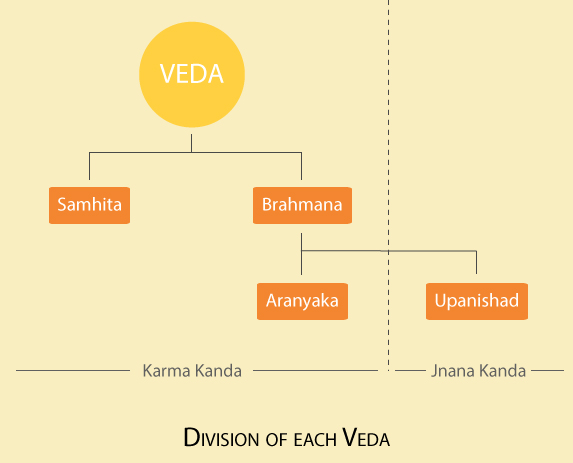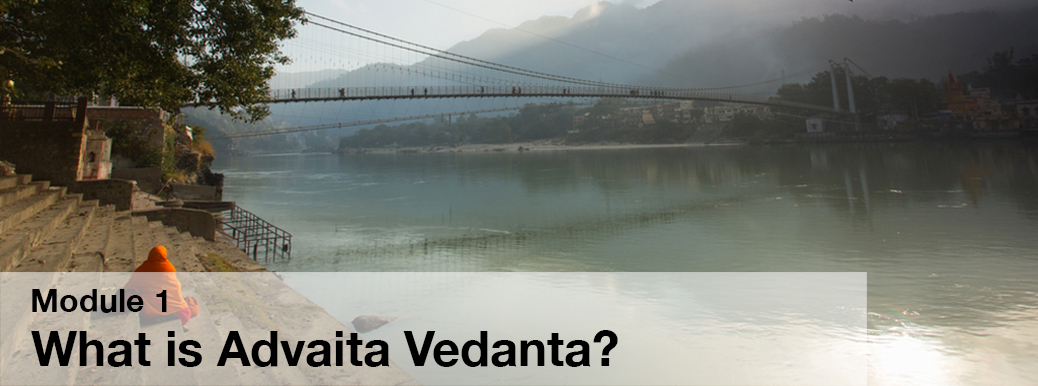Introduction
In this first sub-module we’ll take a look at the Vedas, its origin, meaning, and the major sections in the Veda. We’ll also see how Vedanta is related to the Vedas, and learn about the Upanishads.
The Vedas
The Vedas are called Apaurusheya Jnanam. Apaurusheya means not of human origin, and Jnanam means knowledge. It is revealed knowledge (Shruti). This is an important point because it means that Vedas were not composed by human beings through intellectual and logical reasoning.
The Vedas were revealed to the Rishis (a Seer, ‘one who sees’) of ancient India who had purified, tuned and made their mind single pointed through meditation.
There are in total 4 Vedas:
- Rig Veda
- Yajur Veda
- Sama Veda
- Atharva Veda
Each Veda is primarily divided into two main sections.
- Karma Kanda (Action Section)
- Jnana Kanda (Knowledge Section)
Karma Kanda focuses on Dharma, Karma, rituals, and other special actions meant to achieve security (Artha) and pleasures (Kama). This is the biggest section in each Veda because it deals with the various human desires and the actions needed to fulfill them. Since the means to achieve the desires are actions (Karma), this section is called the Action Section.
The second section, Jnana Kanda, is a much shorter section because it deals with only one human desire; the desire for liberation (Moksha). Moksha cannot be gained through any action, but only through knowledge. Hence this is called the Knowledge Section.
Karma Kanda (Action Section)
According to the Vedas, every action (Karma) we do has a subtle result. The reason it’s called subtle is because the result may not be immediately evident.
If the action follows the rules of Dharma, the result is Punya (merit), or what we call in modern parlance “good Karma”. This Punya would lead to a pleasant, enjoyable experience in future.
When an action breaks the rules of Dharma, it’s called Adharma, also known as “bad Karma” in modern parlance. The subtle result of Adharma is Papa (demerit). Papa would lead to an uncomfortable or painful experience in future.
So the do’s (Dharma) and don’ts (Adharma) mentioned in Karma Kanda are important for all those who seek to gain happiness and avoid sorrow in life.
The rewards of Punya may also lead one to heaven, but the concept of heaven in the Vedas is different from other religions. Heaven in Vedas is a temporary stay.
You stay in heaven as long as you have Punya to spend. You leave heaven once your Punya is exhausted. So heavenly life is not eternal.
If heaven is temporary, then the gaining of heaven is not liberation. Heaven is achieved through Karma. So there is no liberation through Karma.
Jnana Kanda (Knowledge Section)
In the first section the ultimate end is the gain of security and pleasure in this world. However in the second section the ultimate end is knowledge itself. This is a very important point.
Jnana Kanda also has a special name called Vedanta. The word “Vedanta” is a combination of two Sanskrit words: “Veda” (Knowledge) and “Anta” (End). Vedanta literally means “End of Knowledge”.
Vedanta is the knowledge that ends one’s search for knowledge.
The Upanishads
It is the Upanishads that constitute the foundation of Vedanta. All other subsequent literature in Vedanta is of human origin and derived from the Upanishads.
Definition of Upanishad
The word Upanishad means the “destruction of ignorance” (shad) by revealing what “sits nearest” (upani) to you. What sits nearest to you is the Self; so Self-Knowledge destroys ignorance.
The 2nd and more expanded definition of the term Upanishad is as follows.
Upanishad consists of 3 portions: “Upa”, “Ni” and “Shad.
The “Upa” part is derived from the statement “Guru Upa Sadanam”, approaching a Guru.
Why do you need to approach a Guru?
The reason is that even though Vedanta contains Self Knowledge, this knowledge cannot be gained easily. The knowledge contained in the Upanishads needs to be taught in a proper, time-tested manner.
And the person who has the key to this knowledge is the Guru. Hence “Guru Upa Sadanam” (approaching the Guru) is required for gaining the knowledge, and therefore the “Upa” part.
The second part “Ni” means “Nischaya Jnanam”, knowledge which is free from obstacles.
The scriptures talk about two types of obstacles: Samshaya which means “doubt”, which is an intellectual obstacle, and Viparyaya which means “unhealthy emotional habits”, which is an emotional obstacle.
So as long as intellectual and emotional obstacles exist, knowledge (Jnanam) is obstructed. So Nischaya Jnanam means removal of doubts and unhealthy emotional habits.
So first we go to the Guru. This process is called Shravanam (listening to the teaching), the first stage of Self Inquiry.
In the second stage we remove doubts concerning the teachings, which is called Mananam.
And in the third and last stage we remove the unhealthy emotional habits which allow us to assimilate the teachings, which is called Nididhyasanam.
Therefore “Upa” and “Ni” indicate Shravanam, Mananam and Nididhyasanam (the 3 stages of Self Inquiry) to gain the knowledge.
The final portion is “Shad” which is derived from the statements “Nivritti Nasha” and “Avashadanam Nasha”. Nasha means destruction; destruction of all obstacles, especially the ignorance obstacle.
So when one gains firm knowledge through the 3 stages of Self Inquiry (Shravanam, Mananam and Nididhyasanam), ignorance is destroyed.
Therefore “Upanishad” means the wisdom which is gained through the 3 stages of Self-Inquiry, and that which destroys ignorance.
What Constitutes as an Upanishad?
So a single Upanishad may contain one dialogue or a set of dialogues. And all 4 Vedas, especially in the end portion, we have many Upanishads; in fact hundreds of Upanishads.
The 10 Main Upanishads
The ten major Upanishads are:
- Īṣa
- Kena
- Kaṭha
- Praṣna
- Muṇḍaka
- Māṇḍūkya
- Taittirīya
- Aitareya
- Chāndogya
- Bṛhadāraṇyaka
These 10 are considered to be the most important as they give the essence of all the Upanishads.
These 10 Upanishads were analyzed by Vyasa in his Brahma Sutras, and commentaries were also written on them by Adi Shankara. (We’ll talk more about Adi Shankara in the 4th sub-module “Role of Vedanta”)
That’s how these 10 Upanishads became prominent and widely studied. So studying these 10 Upanishads is as good as studying all the Upanishads.
These ten are popularly known as Dasa Upanishads or Dasopanishads; “Dasa” meaning ten. So for easy remembrance the names of these 10 Upanishads are presented in the form of a verse.
Isa Kena Katha Prasna Mundaka Mandukya Thithiri Aitareyancha Chandogyam Brihadaranyakam Dasa.

Of these 10 Upanishads 4 are from Yajur Veda, 3 from Atharva Veda, 2 from Sama Veda and 1 from Rig Veda.
It’s important to note that this verse does not give the order of study, it just enumerates the 10 Upanishads. In fact the first one, Isavasya Upanishad, is the most difficult one of them all and is not to be studied first.
Division of each Veda

The 4 sections of the Vedas symbolically represent the 4 stages of a human life called Ashrama, and each section contains rituals and guidance for that particular stage.
The first stage is Brahmacharya or a bachelor student stage. The 2nd stage is Grihastha or householder stage. The 3rd stage is Vanaprastha or retired life. And last and 4th stage is Sannyasa or renounced life.
So each section of the Veda corresponds to each stage in life, but it’s only symbolical and not a hard and fast rule.
We also mentioned previously that Upanishads are found in the Jnana Kanda section or the later part of the Vedas. However this is not always the case.
In some cases, Upanishads are found in the earlier, Samhita section also. Such Upanishads are called Samhita Upanishad or Samhitopanishad or Mantra Upanishad or Mantropanishad, and Upanishads occurring in the Brahmana section are called Brahmana Upanishad or Brahmanopanishad.
And Brahmanopanishads are generally considered to be a commentary or an elaboration on the Samhitopanishad found in the earlier section in the same Veda.
Summary
| 1. | Vedas were not composed by human beings. |
| 2. | There are 4 Vedas. Each Veda is divided into two main sections: Karma Kanda (Action Section) and Jnana Kanda (Knowledge Section). |
| 3. | Karma Kanda deals with gaining security and pleasure in the world, and the rules of Dharma. |
| 4. | Actions that follow Dharma accrue Punya, and actions that break Dharma accrue Papa. Punya may lead to heaven, but since heaven is temporary, it’s not liberation. So Karma can never lead to liberation. |
| 5. | Jnana Kanda deals with only one subject matter: Moksha (liberation). |
| 6. | The Jnana Kanda section is also called Vedanta. The Jnana Kanda section may contain one or many Upanishads. |
| 7. | Of the 108 extant Upanishads, 10 are considered to be the most important as they give the essence of all the Upanishads. These ten Upanishads are called Dasopanishads. |
| 8. | The word “Upanishad” means the wisdom that is gain through the 3 stages of Self-Inquiry (listening, removing doubts and assimilation), and that which destroys ignorance. |
| 9. | One dialogue or a set of dialogues put together constitutes a single Upanishad. |
| 10. | A Veda can also be divided alternately into 4 sections: Samhita (mantras) and Brahmana (rituals), and the Brahmana portion also includes 2 sub-sections: Aranyaka and Upanishad. |
| 11. | Upanishads found in the Samhita section are called Mantropanishad or Samhitopanishad, and Upanishads found in the Brahmana section are called Brahmanopanishad. |


